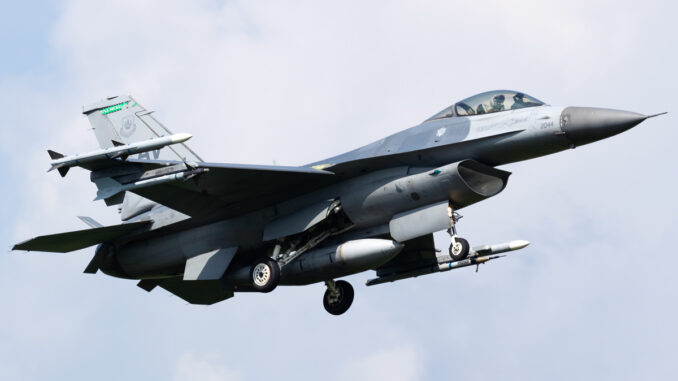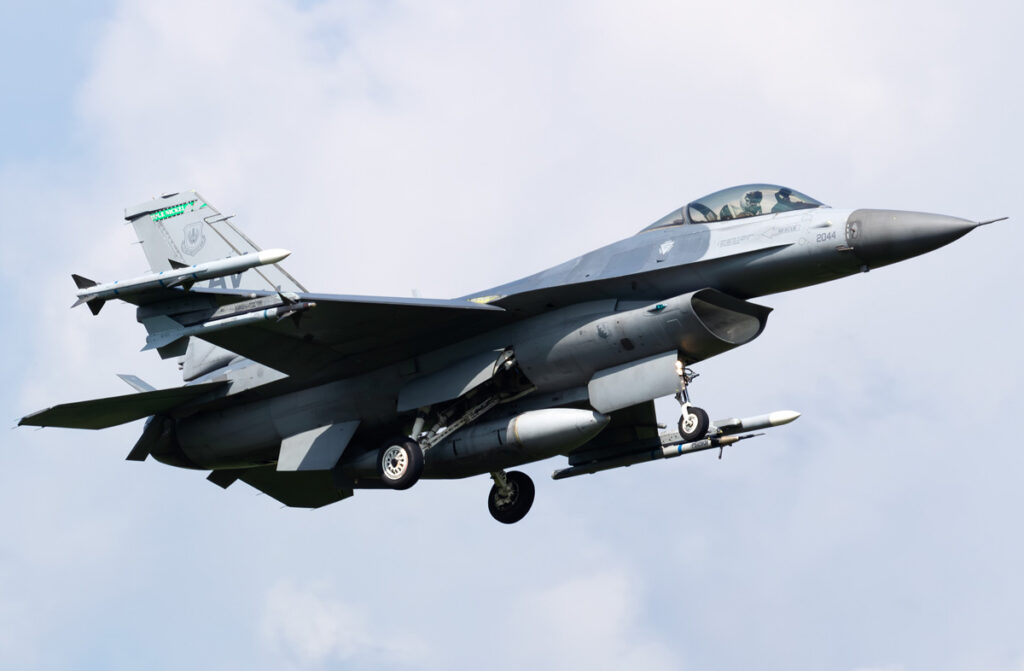
Ukraine is replacing its MiG-29s with F-16s thanks to deliveries from NATO, thereby strengthening its air capacity against Russia.
Since the Russian invasion of 2022, Ukraine has lost a considerable proportion of its original air fleet, which consisted mainly of MiG-29s and Sukhoi. In response, Ukraine has asked its NATO allies to supply it with F-16s, Western multi-role fighters. With production of the F-35 ramping up, many European and American countries have surplus F-16s ready to be transferred to Ukraine. This replacement of the Ukrainian fleet with F-16s represents a major strategic shift, providing Ukraine with more modern and capable aircraft to counter Russia’s declining air power.
Replacing MiG-29s with F-16s: a turning point in the war in Ukraine
Since the start of the conflict in 2022, Ukraine has seen its fighter fleet, mainly made up of MiG-29s and Sukhoi, heavily affected. Many of these aircraft have been destroyed or rendered inoperable, leaving a gap in the country’s air capacity. Faced with this situation, Ukraine asked its NATO allies for help, specifically requesting F-16s to replace the lost aircraft.
The F-16, a multi-role fighter developed by the United States in the 1970s, has become one of the world’s most popular combat aircraft, with over 4,600 units produced to date. Unlike the MiG-29, the F-16 benefits from a more reliable design and an extended service life, which can exceed 8,000 flight hours with recent upgrades. In addition, the F-16 is equipped with modern weapons systems, including advanced air-to-air missiles and guided bombs, offering greater combat effectiveness.
With the arrival of the F-35, the F-16s are gradually being replaced in Western air forces, creating an opportunity for Ukraine to acquire these aircraft. The transfer of F-16s to Ukraine began recently, with the first deliveries of over 100 units scheduled. Ukrainian pilots, already trained on the MiG-29, quickly demonstrated their ability to adapt to the F-16, accelerating the integration of these aircraft into their fleet.
The strategic role of the F-16 in the conflict
The introduction of the F-16 into the Ukrainian arsenal is more than a simple replacement of aircraft. It is a strategic response to the decline in Russian air power, which has been severely affected by economic sanctions and battlefield losses. While Russia still has around 1,000 fighter aircraft, many are stationed far from the conflict zones in Ukraine, limiting their effectiveness.
The F-16s offer Ukraine a significant technological advantage. Not only are these aircraft more modern than the MiG-29, they are also more versatile. Thanks to their ability to carry sophisticated weaponry, such as anti-radar missiles and GPS-guided bombs, the F-16s enable Ukraine to carry out more precise and devastating air operations against Russian forces.
In addition, the integration of F-16s into the Ukrainian air force strengthens ties with NATO, since these aircraft are compatible with Western weapons systems and operational doctrines. This not only facilitates maintenance and logistical support, but also enables better coordination with the air forces of NATO member countries. This support is crucial for Ukraine, which depends on its allies to maintain its combat capability against Russia.

Comparison between the F-16 and the MiG-29: advantages and disadvantages
The MiG-29, introduced in the 1980s, was once a mainstay of the Soviet air force and was widely exported to other countries. However, compared with the F-16, the MiG-29 has several disadvantages. Firstly, the reliability of the MiG-29 has always been a problem, with an initial service life of just 2,500 flying hours, compared with 4,000 hours for the early F-16 models. Although Russia has tried to improve the durability of the MiG-29, the results have been limited, not least because of recurring mechanical and electronic problems.
The F-16, on the other hand, has benefited from several improvements over the decades. The most recent models, such as the F-16V, are equipped with AESA electronically scanned radars, a fully digital cockpit and advanced fire control systems, making them much more capable fighter aircraft. In addition, the F-16 is known for its superior manoeuvrability and its ability to carry a wide range of weapons, making it adaptable to various types of mission, from air interception to ground strikes.
Another major advantage of the F-16 is its ability to operate for long periods without requiring intensive maintenance. This contrasts with the MiG-29, which, despite its impressive performance on paper, requires frequent servicing to remain operational. This difference in reliability and maintenance cost makes the F-16 a more cost-effective and viable long-term option for Ukraine.
Consequences of F-16 integration for Ukraine
The integration of F-16s into the Ukrainian air force could have significant consequences for the development of the conflict with Russia. Firstly, these aircraft could enable Ukraine to regain the upper hand in the air, in particular by carrying out more precise strikes and denying Russian forces access to certain areas. This could also deter Russia from launching massive air attacks, given that Ukraine now has effective means of defence.
In addition, the arrival of the F-16s could boost the morale of the Ukrainian armed forces, giving them more modern tools with which to defend themselves. It could also send a strong signal to Russia and the international community that Ukraine is capable of modernising its armed forces despite the ongoing war.
However, the integration of the F-16s will not be without its challenges. The training of pilots and maintenance personnel, although already underway, will take time. In addition, Ukraine will have to ensure that the infrastructure needed for F-16 maintenance and logistics is in place, which will require additional investment.
Finally, the delivery of the F-16s to Ukraine could have wider geopolitical repercussions. Other countries in the region, observing Ukraine’s increased capabilities, could be encouraged to modernise their own air forces, leading to a new arms race in Eastern Europe. This could also complicate relations between Russia and NATO countries, increasing tensions in an already unstable region.
A crucial reinforcement for Ukraine
The replacement of MiG-29s with F-16s represents a major turning point for the Ukrainian air force. These aircraft, although older than the F-35, offer a proven and reliable solution for strengthening Ukraine’s defence capabilities in the face of a Russia increasingly weakened by economic sanctions and military losses. By integrating the F-16s, Ukraine is demonstrating its determination to modernise its armed forces and maintain its sovereignty in the face of Russian aggression.
However, this transition will not be without its challenges. Ukraine will have to overcome logistical and technical obstacles to maximise the effectiveness of these aircraft in the ongoing conflict. Nevertheless, with the continued support of its NATO allies, Ukraine is well positioned to take advantage of this new air capability and strengthen its national defence in the long term.
War Wings Daily is an independant magazine.